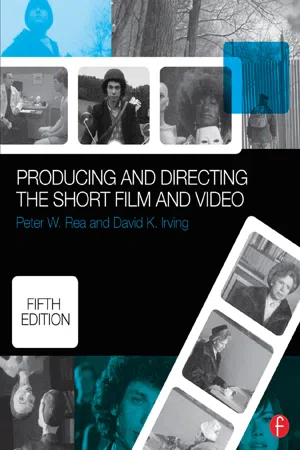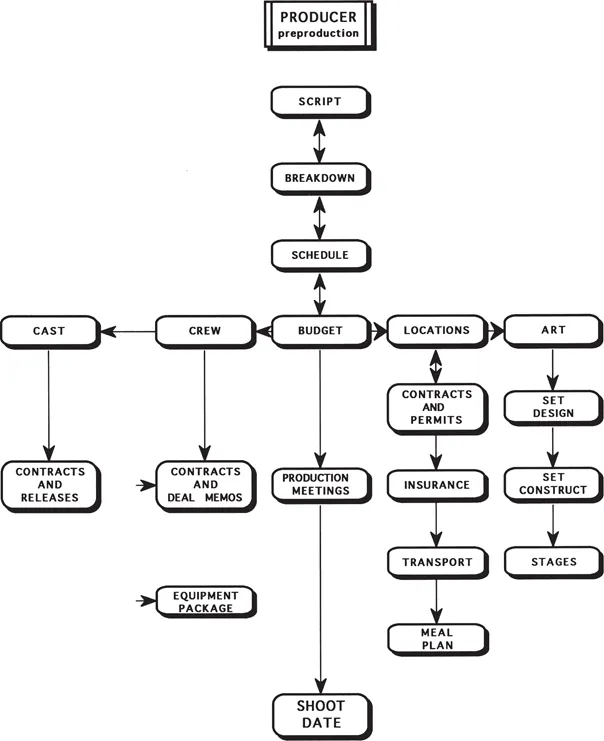![]()
part I
So, the first thing I did was I made a shot list, and I figured out how many shots there would be in the movie, and then roughly tried to figure out how many days I would need to shoot. That was the smartest thing I did.
Luke Matheny
You have a script you feel strongly about and are eager to get out into the field and begin production. Assuming that you have secured the appropriate funds (or are well on your way to doing so), you are now ready to start preproduction. During this phase, you will prepare virtually every element for the filming process. Decisions made during this time are the foundation on which everything else is built. The producer and director share many of these responsibilities. The next 11 chapters of this book indicate the specific responsibilities of each. These responsibilities are outlined in Figures I.1 and I.2.
THE STUDENT PRODUCER—DIRECTOR CONUNDRUM
Although the producer and director share many of the responsibilities, they each have their own sphere of focus. Our timeline in the beginning of the book (see page xxv) articulates the director’s and producer’s flow of activity from script to screen. They intersect on creative decisions but veer off on organization and management. They both are involved with choosing a location; however, the location manager scouts these locations and the producer negotiates the deal. The producer works hard to execute the creative plan within the budget.
If the producer and director are one and the same, not only is the important give-and-take lost between the creative desires and the realities of what is possible and affordable, but the director must now do double duty. She must not only choose the right locations for the story, but must also spend hours scouting, negotiating with the tenants, and securing the permits (if necessary). Swamped with “producing or managerial” duties, the novice inevitably puts little time in her role as director. The directorial plan (visual style, floor plans, storyboards, etc.) is often devised at the last minute.
We also acknowledge that “student producers” do not follow the industry model. The director usually brings the money to the table. A student producer’s role is more that of a production manager or line producer but, if he does the job right, he can be an indispensable asset and aid to the director. Jessalyn Haefele, the student producer of Citizen, says this about producing:
When James emailed me the original draft of Citizen and asked if I would be interested in producing it, I was blown away. The script was very, very good (it was tight and gripped me), but almost more importantly, the entire time I was reading it, I was thinking to myself, “How the heck can I pull this off?” The challenge of actually getting this film made is one of the main reasons I was attracted to this project.
There are a lot of great things about producing films, especially student thesis films, but here are a few reasons why, if you ultimately want to be a producer, you can learn more from them than anything else:
1. Most student thesis films are self-financed, or the money is already in place. This means that you don’t have the pressure of fund-raising on your shoulders, or not having money at the last minute—the money is already there. And even better, it’s not your money! It’s someone else’s, and you get to figure out how to make the best use of it. It’s a real, practical learning experience.
2. Most (if not all) student films are already provided with production insurance through the school. This means you don’t have to blow your budget buying production insurance, and it’s really a convenient thing to have.
3. You easily have more access to crew members, and there is a good chance that many of them are your classmates and you already have a working relationship with them.
4. Mistakes are more easily tolerated, and as a learning environment, there is less pressure. It’s a good environment in which to hone your skills and discover what works and what does not.
Jessalyn Haefele, Producer of Citizen
Figure I.1 Producer’s preproduction responsibilities.
Figure I.2 Producer’s preproduction responsibilities.
PREPARE THOROUGHLY FOR THE SHOOT DATE
Preproduction is the time to research and develop your idea, to design what it should look like, and to explore all the variables such as cast, crew, and locations needed to create a successful production. The more thoroughly a project is planned, the smoother the production will be. The general rule is: You can’t do too much preproduction work. For some reason, this is a difficult concept for many novices to understand. They often return from their first major shoot dejected, having experienced just how ill prepared they really were. They realize too late that mistakes or disasters during production could have been averted if they had been more organized before they started to shoot. All the talent in the world won’t help if your schedule isn’t realistic, the meals aren’t served on time, you lose the use of your location, or you don’t have enough film stock on hand. These are only a few of the contingencies that require forethought.
One of the major goals of preproduction is to try to anticipate anything and everything that can go wrong during a shoot. This gives you time to react sensibly to things that could not have been anticipated and are entirely beyond your control (and invariably occur, such as unusual weather, acts of God, etc.). These things happen because all film shoots are ruled by Murphy’s Law: Anything that can go wrong inevitably will. When you plan a production and work with this assumption, always plan for the worst-case scenario.
The best advice I can give is to have a sense of humor about film production. Embrace the Murphy’s Law of it all—for everything that can go wrong surely will. But if you expect it, and are prepared for it, you will greet these obstacles with a smile rather than a scream.
Jessalyn Haefele, Producer of Citizen
After two days of shooting, New York got hit with the worst blizzard in 50 years.
James Darling
PREPRODUCTION IS QUALITY TIME
During preproduction, you have an abundance of something you won’t have when you start shooting: time—time to consider various ways to shoot a scene, pick the right actor, settle on the right location, or spend on the subtleties of the script. Never lose sight of the fact that this is cost-effective time. All the effort you expend on preparation now will pay off during production. When you’re actually shooting, spending time is spending money. Settling on an efficient game plan and solving potential production problems during preproduction will save precious dollars later.
I spent a lot of hours in Grand Central, almost an entire day, getting a sense of the building. That was when I first noticed how the light streams through the windows.
Adam Davidson
WITHOUT A GOOD SCRIPT, YOU CANNOT MAKE A GOOD FILM
Even after developing a good screenplay, as discussed in Chapter 1 “Script,” there is no guarantee of producing a good film. However, a poorly thought out script has little chance of yielding a successful finished product. You would be ill advised to go out into the field with a story that doesn’t live up to its full potential. The investment of time, money, talent, and effort will be wasted unless the original blueprint is solid.
To ensure that you have the best script possible, be prepared to rewrite many times. Don’t expect to solve lingering script problems magically during production. Rewriting the script on the set is usually too demanding for beginning filmmakers. The pressures of filming the original script will keep you more than occupied.
It is true that many serendipitous events can occur during shooting and editing that will add evocative imagery, inspired characters, and atmospheric locations to your project. Unexpected surprises in action or dialogue will add measurably to the texture of a scene, but don’t count on them. The script will come to full-color life, but the progression of events—your story—will not change. Script problems will then become editing challenges. What is on the page will end up on the screen. Get it right before your start.
PREPRODUCTION GUIDELINES
Intangible managerial skills are as important as technical know-how in preparing successfully for production. The following are some general guidelines to help with the intangibles of preproduction.
Keep a Positive Attitude. Lack of experience makes it difficult for beginning filmmakers to assess their day-to-day preproduction progress. There are so many elements (cast, crew, locations) that have to fall into place that you might sometimes doubt that so man...


